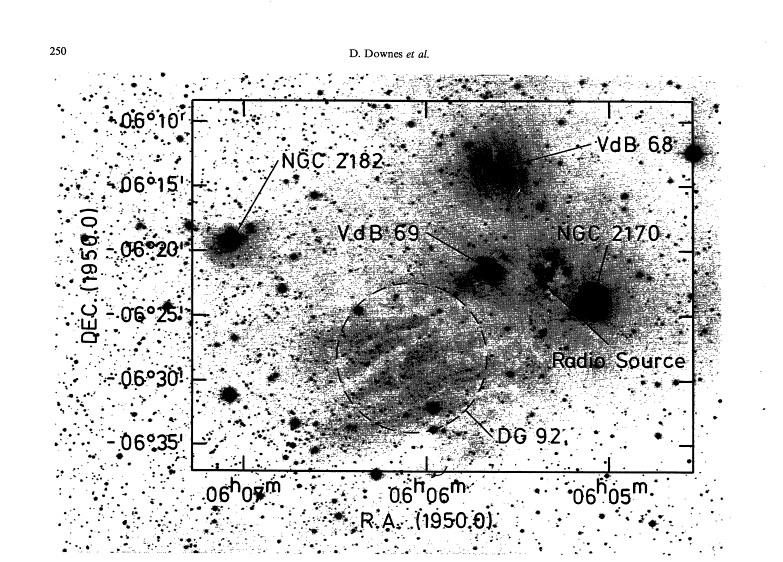
This rich collection of predominantly reflection
and sparse emission nebulosity exists in the western part of a
vast star forming region known as the Mon R 2 association. The
"R" designation stands for reflection and indicates
an association of stars illuminating reflection nebulae. Most
of the members of Mon R 2 are type B stars located along an east-west
line stretching across 2 degrees of the winter sky, situated about
8 degrees east of the Orion Nebula. The Mon R 2 association resides
at a distance of 830 pc and formed about 6 to 10 million years
ago along the edge of the elliptically shaped Mon R2 molecular
cloud (dimensions of about 130 x 60 pcs). In 1966 Van den Bergh
first identified this major clustering of nine reflection nebulae
illuminated by an association of B-type stars.
It has been suggested that massive stars form last in stellar
associations and that their subsequent radiation pressure ultimately
disperses the interstellar gas and dust from which lower mass
stars have formed. The likely chronological evolution is: T-Tauri
associations --> reflection nebulae and B-star associations-->
HII regions and O-star associations. The existence of HII regions
within Mon R 2 suggest it may be further evolved than other groups
of reflection nebulae and that favorable conditions have just
been reached for massive star formation. The Mon R2 cloud appears
to have a preferred plane of active star formation. Curiously
young low mass stellar objects seem to predominate along the apparently
younger eastern side of the association while the HII cloud phase
seems to have been reached in the older western side of the association.
The core of the molecular cloud Mon R2 is associated with both
a massive bipolar energetic outflow (one of the largest known
outflows) and several radio sources thought to originate from
water, formaldehyde, and OH Masers. Maser is an acronym for "Microwave
Amplification by Stimulated Emission of Radiation". Masers
form through the interaction between high-energy starlight and
regions rich in various molecules. Both outflow phenomenon and
maser acitivity occur in regions of very active star formation.
These energetic phenomenon arise from the core of the Mon R2 cloud
where a compact HII region and several dust embedded infrared
sources have been identified, thought to be associated with pre-main
sequence objects, presumably evolving hot B-type stars. The reflection
Nebula VdB 68 shows the visible striations characteristic of older
nebulae where the exciting star has begun to destroy the surrounding
molecular material. The reflection nebulae NGC 2170 and VDB 69
show no such striations implying that they may be younger objects
than VDB 68.

The radio source also marks the core of the Mon R2 association.


Core of the Mon R2 association is marked with a "C".
